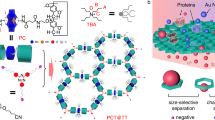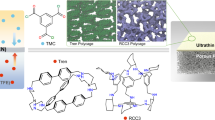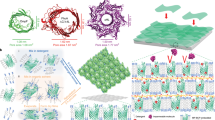Abstract
Most practical materials are held together by covalent bonds, which are irreversible. Materials based on noncovalent interactions can undergo reversible self-assembly, which offers advantages in terms of fabrication, processing and recyclability1, but the majority of noncovalent systems are too fragile to be competitive with covalent materials for practical applications, despite significant attempts to develop robust noncovalent arrays1,2,3,4. Here, we report nanostructured supramolecular membranes prepared from fibrous assemblies5 in water. The membranes are robust due to strong hydrophobic interactions6,7, allowing their application in the size-selective separation of both metal and semiconductor nanoparticles. A thin (12 µm) membrane is used for filtration (∼5 nm cutoff), and a thicker (45 µm) membrane allows for size-selective chromatography in the sub-5 nm domain. Unlike conventional membranes, our supramolecular membranes can be disassembled using organic solvent, cleaned, reassembled and reused multiple times.
This is a preview of subscription content, access via your institution
Access options
Subscribe to this journal
Receive 12 print issues and online access
$259.00 per year
only $21.58 per issue
Buy this article
- Purchase on Springer Link
- Instant access to full article PDF
Prices may be subject to local taxes which are calculated during checkout





Similar content being viewed by others
References
Sijbesma, R. P. et al. Reversible polymers formed from self-complementary monomers using quadruple hydrogen bonding. Science 278, 1601–1604 (1997).
Zimmerman, S. C., Zeng, F., Reichert, D. E. C. & Kolotuchin, S. V. Self-assembling dendrimers. Science 271, 1095–1098 (1996).
Capito, R. M., Azevedo, H. S., Velichko, Y. S., Mata, A. & Stupp, S. I. Self-assembly of large and small molecules into hierarchically ordered sacs and membranes. Science 319, 1812–1816 (2008).
Wang, Q. et al. High-water-content mouldable hydrogels by mixing clay and a dendritic molecular binder. Nature 463, 339–343 (2010).
Krieg, E. et al. Supramolecular gel based on a perylene diimide dye: multiple stimuli responsiveness, robustness, and photofunction. J. Am. Chem. Soc. 131, 14365–14373 (2009).
Ball, P. Water as an active constituent in cell biology. Chem. Rev. 108, 74–108 (2008).
Chandler, D. Interfaces and the driving force of hydrophobic assembly. Nature 437, 640–647 (2005).
Daniel, M. C. & Astruc, D. Gold nanoparticles: assembly, supramolecular chemistry, quantum-size-related properties, and applications toward biology, catalysis, and nanotechnology. Chem. Rev. 104, 293–346 (2004).
Alivisatos, A. P. Semiconductor clusters, nanocrystals, and quantum dots. Science 271, 933–937 (1996).
Siebrands, T., Giersig, M., Mulvaney, P. & Fischer, C. H. Steric exclusion chromatography of nanometer-sized gold particles. Langmuir 9, 2297–2300 (1993).
Murray, C. B., Norris, D. J. & Bawendi, M. G. Synthesis and characterization of nearly monodisperse CdE (E = sulfur, selenium, tellurium) semiconductor nanocrystallites. J. Am. Chem. Soc. 115, 8706–8715 (1993).
Chemseddine, A. & Weller, H. Highly monodisperse quantum sized CdS particles by size selective precipitation. Ber. Bunsen—Ges. Phys. Chem. 97, 636–638 (1993).
Hanauer, M., Pierrat, S., Zins, I., Lotz, A. & Sönnichsen, C. Separation of nanoparticles by gel electrophoresis according to size and shape. Nano Lett. 7, 2881–2885 (2007).
Arnaud, I., Abid, J.-P., Roussel, C. & Girault, H. H. Size-selective separation of gold nanoparticles using isoelectric focusing electrophoresis (IEF). Chem. Commun. 787–788 (2005).
Sun, X. et al. Separation of nanoparticles in a density gradient: FeCo@C and gold nanocrystals. Angew. Chem. Int. Ed. 121, 957–960 (2009).
Bai, L. et al. Rapid separation and purification of nanoparticles in organic density gradients. J. Am. Chem. Soc. 132, 2333–2337 (2010).
Koros, W. J., Ma, Y. H. & Shimidzu, T. Terminology for membranes and membrane processes (IUPAC Recommendation 1996). J. Membr. Sci. 120, 149–159 (1996).
Peng, X., Jin, J., Nakamura, Y., Ohno, T. & Ichinose, I. Ultrafast permeation of water through protein-based membranes. Nature Nanotech. 4, 353–357 (2009).
Huang, L., Wang, D., Tang, H. & Wang, S. Separation and purification of nano-Al13 by UF method. Colloids Surf. A 275, 200–208 (2006).
Sweeney, S. F., Woehrle, G. H. & Hutchison, J. E. Rapid purification and size separation of gold nanoparticles via diafiltration. J. Am. Chem. Soc. 128, 3190–3197 (2006).
Akthakul, A., Hochbaum, A. I., Stellacci, F. & Mayes, A. M. Size fractionation of metal nanoparticles by membrane filtration. Adv. Mater. 17, 532–535 (2005).
El-Safty, S. A. et al. Organic–inorganic mesoporous silica nanostrands for ultrafine filtration of spherical nanoparticles. Chem. Commun. 46, 3917–3919 (2010).
Vandezande, P., Gevers, L. E. M. & Vankelecom, I. F. J. Solvent resistant nanofiltration: separating on a molecular level. Chem. Soc. Rev. 37, 365–405 (2008).
Benfer, S., Árki, P. & Tomandl, G. Ceramic membranes for filtration applications—preparation and characterization. Adv. Eng. Mater. 6, 495–500 (2004).
Ulbricht, M. Advanced functional polymer membranes. Polymer 47, 2217–2262 (2006).
Beginn, U. Supramolecular templates as porogenes. Adv. Mater. 10, 1391–1394 (1998).
Lu, Y., Suzuki, T., Zhang, W., Moore, J. S. & Marinas, B. J. Nanofiltration membranes based on rigid star amphiphiles. Chem. Mater. 19, 3194–3204 (2007).
Yonezawa, T. & Kunitake, T. Practical preparation of anionic mercapto ligand-stabilized gold nanoparticles and their immobilization. Colloids Surf. A 149, 193–199 (1999).
Rogach, A. L. et al. Aqueous synthesis of thiol-capped CdTe nanocrystals: state-of-the-art. J. Phys. Chem. C 111, 14628–14637 (2007).
Gaponik, N. et al. Thiol-capping of CdTe nanocrystals: an alternative to organometallic synthetic routes. J. Phys. Chem. B 106, 7177–7185 (2002).
Vossmeyer, T. et al. CdS nanoclusters: synthesis, characterization, size dependent oscillator strength, temperature shift of the excitonic transition energy, and reversible absorbance shift. J. Phys. Chem. 98, 7665–7673 (1994).
Hostetler, M. J. et al. Alkanethiolate gold cluster molecules with core diameters from 1.5 to 5.2 nm: core and monolayer properties as a function of core size. Langmuir 14, 17–30 (1998).
Foos, E. E., Snow, A. W., Twigg, M. E. & Ancona, M. G. Thiol-terminated di-, tri-, and tetraethylene oxide functionalized gold nanoparticles: a water-soluble, charge-neutral cluster. Chem. Mater. 14, 2401–2408 (2002).
Acknowledgements
This work was supported by grants from the Israel Science Foundation, the Minerva Foundation, the Gerhardt M.J. Schmidt Minerva Center for Supramolecular Architectures, and the Helen and Martin Kimmel Center for Molecular Design. The EM studies were conducted at the Irving and Cherna Moskowitz Center for Nano and Bio-Nano Imaging (Weizmann Institute). B.R. holds the Abraham and Jennie Fialkow Career Development Chair. The authors thank T. Shirman for help with gold nanoparticle synthesis and C. Shahar for assistance with TEM measurements. Thanks also go to D. Milstein for critical reading of the manuscript.
Author information
Authors and Affiliations
Contributions
B.R., H.W. and E.K. conceived the project and planned the experiments. E.K. performed the synthesis and filtration experiments. E. Shimoni and H.W. carried out electron microscopy studies and data analysis. E. Shirman synthesized nanoparticles Au6, Au7, QD1 and QD2 and participated in data analysis. E.K. and B.R. wrote the paper. All authors discussed the results and commented on the paper. All authors contributed extensively to the work presented in this paper.
Corresponding author
Ethics declarations
Competing interests
The authors declare no competing financial interests.
Supplementary information
Supplementary information
Supplementary information (PDF 4797 kb)
Supplementary information
Supplementary movie (MOV 5327 kb)
Rights and permissions
About this article
Cite this article
Krieg, E., Weissman, H., Shirman, E. et al. A recyclable supramolecular membrane for size-selective separation of nanoparticles. Nature Nanotech 6, 141–146 (2011). https://doi.org/10.1038/nnano.2010.274
Received:
Accepted:
Published:
Issue Date:
DOI: https://doi.org/10.1038/nnano.2010.274
This article is cited by
-
Shape control in 2D molecular nanosheets by tuning anisotropic intermolecular interactions and assembly kinetics
Nature Communications (2023)
-
Effect of perylene assembly shapes on photoelectrochemical properties and ultrasensitive biosensing behaviors toward dopamine
Analytical and Bioanalytical Chemistry (2023)
-
Oriented arrangement of simple monomers enabled by confinement: towards living supramolecular polymerization
Nature Communications (2021)
-
Coordination cages as permanently porous ionic liquids
Nature Chemistry (2020)
-
Go with the flow: advances and trends in magnetic flow cytometry
Analytical and Bioanalytical Chemistry (2019)



